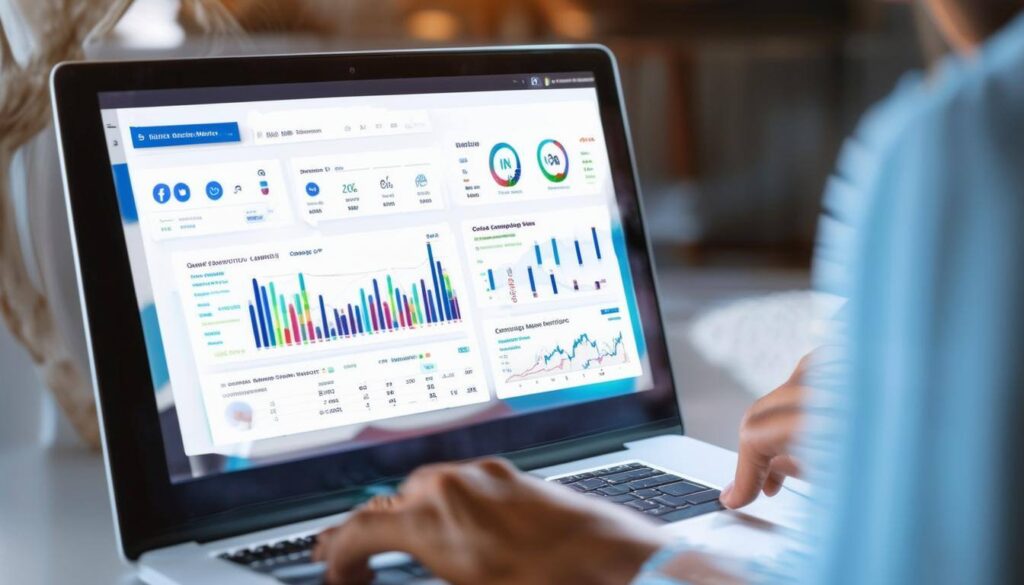Organic traffic is often the first metric a business looks at to gauge the health of its Search Engine Optimization (SEO). It’s easy to track and satisfying to watch the number of visitors climb. However, obsessing over organic traffic alone is like checking the fuel gauge without looking at the map. It tells you something is happening, but it doesn’t confirm you’re heading toward your destination: sustainable business growth.
The modern SEO landscape demands a more sophisticated approach. Success isn’t about pageviews; it’s about profit, leads, and customer value. True SEO mastery requires shifting your focus from “vanity metrics” that look good on a report to “performance metrics” that directly impact your bottom line. We need to measure what people do once they arrive. This deeper level of measurement is the core of conversion-focused SEO, a strategic approach that aligns your optimization efforts with tangible business outcomes.
Why is Focusing Only on Organic Traffic a Problem?
Traffic volume, while important, is an incomplete measure of success. A million visitors per month is meaningless if none of them purchase a product, sign up for a service, or download an asset. This is why organic traffic is often called a “vanity metric.” It inflates ego but doesn’t fill the bank.
You could be ranking for keywords that are high-volume but completely irrelevant to your products. This mismatch results in a flood of traffic that immediately bounces away, providing no value. The true goal of SEO is not just to attract visitors, but to attract the right visitors, those with high commercial intent who are ready to convert.
Therefore, for SEO to be considered a true performance channel, its success must be measured by metrics that are inextricably linked to financial results. These are the metrics that move the needle and provide a clear picture of your organic revenue.

Which Conversion Metrics Directly Tie SEO to Revenue?
The most crucial metrics go beyond simple rankings to measure the real-world value of your organic strategy. These are the monetary and conversion KPIs that executive teams truly care about.
The following metrics are essential for proving SEO’s value:
- Conversion Rate (CR): This is arguably the single most important metric for any digital marketing channel.
- It measures the percentage of organic visitors who complete a desired action, such as submitting a lead form, making a purchase, or signing up for a newsletter.
- The formula is simple: (Number of Conversions/Total Organic Visitors)×100.
- A high Conversion Rate proves that your organic traffic is high-quality and your landing page experience is effective.
- Total Conversions/Leads: This metric tracks the absolute number of goal completions driven by organic search.
- It’s a tangible number that directly feeds into your sales funnel.
- For e-commerce, this is the number of sales; for B2B, it’s the number of qualified leads.
- Customer Lifetime Value (CLV): This is the total revenue a customer is expected to generate over their entire relationship with your business.
- SEO-driven customers often have a higher CLV because they are actively searching for a solution, making their intent stronger.
- Tracking this helps justify a greater investment in long-term organic strategies.
- SEO Return on Investment (ROI): The ultimate proof of concept that ties all metrics together.
- It calculates the net profit (revenue minus costs) generated by organic search.
- A positive ROI confirms that your SEO strategy is a revenue generator, not just a cost center.
- It is calculated as: (Organic Profit−SEO Costs)/SEO Costs×100.
- Cost Per Acquisition (CPA): This measures the total cost of acquiring one customer through organic SEO efforts.
- Compared to paid advertising, organic CPA should ideally be much lower over time, highlighting the efficiency of the channel.
- It helps you understand how scalable and cost-effective your organic strategy is.
By tracking these conversion and monetary metrics, you shift the conversation from “We got more traffic” to “We generated $50,000 in new revenue this quarter, and our cost of acquisition dropped by 15%.”
What User Behavior Signals Should Be Tracked to Improve Content Quality?
User behavior signals indicate how well your content and website meet the needs of the organic visitor. These metrics tell Google whether users are satisfied with the answer they found. High satisfaction is a strong signal that boosts your rankings.
- Average Session Duration / Dwell Time: How long a user actively spends on your site during a session.
- Why it matters: A longer duration suggests the visitor is engaged, finding value, and the content is relevant to their search query.
- Aim for an engaged session time that is long enough for users to consume your content.
- Bounce Rate: The percentage of visitors who leave your site after viewing only a single page.
- Why it matters: A high bounce rate (especially on conversion-focused pages) signals a poor user experience, irrelevant content, or slow load times.
- The goal is to reduce your bounce rate by improving content-to-search-intent matching and site usability.
- Pages Per Session: The average number of pages a user visits during a single session.
- Why it matters: A high number shows that your internal linking structure is effective and your content is compelling enough to encourage further exploration.
- This metric is a direct sign of a well-architected and valuable user journey.
- Organic Click-Through Rate (CTR): The percentage of users who click on your search result after seeing the impression on the Search Engine Results Page (SERP).
- Why it matters: A strong CTR proves that your title tag and meta description are highly compelling and accurately reflect the page’s content.
- A high CTR can actually boost your rankings, even if your page position hasn’t changed, because it tells Google your listing is more attractive than your competitors’.
These engagement metrics provide actionable insights. If a page has low traffic but a very high conversion rate, you should focus your optimization efforts on boosting its authority and ranking. Conversely, if a page has high traffic but poor engagement, you need to rewrite the content or improve the user experience to keep visitors on the site.
How Do Technical Metrics Influence Your SEO Success?
While conversions and engagement focus on the visitor, technical metrics focus on the website’s health and performance. A technically flawed website will struggle to rank, regardless of the quality of its content or its backlink profile.
Core Web Vitals (CWV): This is a set of three specific Google metrics that measure the real-world user experience of a website, and they are now confirmed ranking factors.
- Largest Contentful Paint (LCP): Measures loading performance.
- It marks the point when the main content of the page is likely loaded.
- Goal: LCP should occur within 2.5 seconds of when the page first starts loading.
- Interaction to Next Paint (INP): Measures interactivity and responsiveness. (Replacing First Input Delay, FID).
- It assesses a page’s overall responsiveness to user interactions, such as clicks, taps, or key presses.
- Goal: INP should be at most 200 milliseconds.
- Cumulative Layout Shift (CLS): Measures visual stability.
- It quantifies the unexpected movement of visual page content (like a button moving while you try to click it).
- Goal: CLS should be at most 0.1.
Other Critical Technical KPIs:
- Page Load Time / Site Speed: This is a broader measure of how quickly your page content loads.
- Faster pages have lower bounce rates and higher conversion rates, directly improving business outcomes.
- Studies show that users expect a load time of 2.5 seconds or less.
- Number of Indexed Pages: This is the count of pages on your site that Google has successfully crawled and included in its search index.
- If a page isn’t indexed, it cannot rank.
- Tracking this helps you identify indexing issues or crawl errors that prevent your content from being visible.
- Mobile Traffic Percentage & Usability: Given that a majority of searches now occur on mobile devices, tracking your mobile-friendliness is crucial.
- Your site must be responsive and load quickly on all screen sizes to satisfy Google’s mobile-first indexing policy.
- Mobile-friendliness is a direct ranking factor.
These technical health metrics are the foundation of SEO success. You can’t build a mansion on sand; you must fix the technical foundation before you can expect your content and conversion efforts to pay off.

Why Do Authority Metrics Remain Crucial for Long-Term Growth?
Authority metrics measure your website’s perceived strength, trust, and credibility in the eyes of search engines. These are the long-term indicators of SEO health that dictate your overall ranking ceiling.
- Domain Authority (DA) / Domain Rating (DR): These are proprietary scores (from Moz, Ahrefs, Semrush, etc.) that predict how well your website will rank in SERPs compared to competitors.
- These scores are heavily weighted by the quality and quantity of your backlink profile.
- They provide a simple, competitive benchmark for the overall strength of your domain.
- Backlinks (Quantity and Quality): Backlinks from other reputable, high-authority websites act as digital votes of confidence.
- They are one of the most important traditional ranking factors.
- It’s not just the number that matters; the authority and relevance of the linking site are far more critical.
- Referring Domains: This tracks the total number of unique websites that link to your site.
- A growing number of referring domains indicates a healthy and diversified link profile, which is a sign of long-term organic authority.
Building domain authority is a marathon, not a sprint. It requires a sustained, strategic focus on creating high-quality, link-worthy content and engaging in outreach. Authority is the power source that ultimately allows your pages to rank and your organic traffic to grow exponentially.
Conclusion: Aligning SEO to the Bottom Line
SEO success isn’t defined by the size of your audience; it’s defined by the quality of the outcomes you achieve. While organic traffic is a good starting point, the true measures of a high-performing SEO strategy are rooted in conversion, user experience, and financial returns.
To master performance marketing through SEO, you must:
- Prioritize Conversion Metrics: Focus on Conversion Rate, Leads, and ROI to ensure your work is profitable.
- Optimize User Experience: Track Dwell Time, Bounce Rate, and Core Web Vitals to satisfy both users and search engines.
- Build Real Authority: Strategically grow a high-quality Backlink profile to increase your Domain Authority.
By tracking this comprehensive set of metrics, you transition from simply reporting on activity to proving tangible results. This strategic, data-driven approach is how SEO transforms from a marketing expense into your most valuable, long-term acquisition channel.
Ready to see your organic traffic turn into real revenue?
If your SEO reports are all about traffic and rankings, but your sales reports aren’t reflecting the growth, it’s time for a change. Finch specializes in performance marketing that strategically aligns every SEO move with your business’s financial goals. We don’t just get you clicks; we get you customers.
Contact Finch today for a performance audit and start measuring what truly matters for your bottom line.
Frequently Asked Questions About SEO Metrics
What is the difference between an SEO metric and an SEO KPI?
A metric is a standard unit of measurement, such as organic traffic, page load time, or the number of backlinks. A Key Performance Indicator (KPI) is a strategic metric that is directly tied to a specific business objective or goal. For example, “Organic Traffic” is a metric, but “Organic Conversion Rate” is a KPI because it measures the performance against the goal of generating revenue. KPIs are the most crucial metrics for proving the commercial value of your SEO efforts.
What is a “good” organic conversion rate?
A “good” organic conversion rate varies significantly by industry, business model (e-commerce vs. lead generation), and product price point. For most general industries, a conversion rate between 2% and 5% is often considered solid performance. However, high-intent keywords can drive conversion rates much higher (e.g., 10%+ on bottom-of-funnel pages). The best benchmark is your own historical data and the conversion rates of your direct, top-performing competitors. The focus should be on improvement over time, not a static, universal number.
Why are Core Web Vitals considered such important SEO metrics now?
Core Web Vitals (CWV) are important because they are direct measures of user experience (UX), and Google has officially made them a ranking factor. A positive user experience, meaning your page loads fast, is interactive, and doesn’t shift unexpectedly, leads to lower bounce rates and higher engagement. By improving your CWV scores, you satisfy the user, which in turn signals to Google that your site is high-quality, resulting in a potential boost in search rankings and ultimately better conversion rates.
How is “Dwell Time” different from “Average Session Duration”?
Average Session Duration is the total time a user spends on your website across all pages during one session. Dwell Time (or “Time on Page”) is specifically the time a user spends on a single page before returning to the search engine results page (SERP). Dwell Time is a more direct indicator of a page’s quality and relevance to the original search query. A long Dwell Time is a strong positive signal to search engines that the user found the content useful and satisfying.
If my Organic CTR is high, does that mean my page will rank higher?
A high Organic CTR is a strong signal that your page listing is highly relevant and attractive to searchers, and Google’s algorithm may interpret this user behavior as an indicator of quality. This is often referred to as a “ranking factor.” If your CTR is significantly higher than other pages ranked above you, Google may test moving your page up in the search results to satisfy more users. Therefore, optimizing your title tags and meta descriptions for a high CTR is one of the most immediate ways to impact your visibility and potentially improve your rankings.

